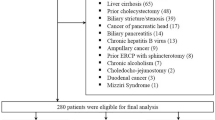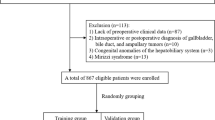Abstract
Background
There are risks of choledocholithiasis in symptomatic gallstones, and some surgeons have proposed the identification of choledocholithiasis before cholecystectomy. Our goal was to evaluate the diagnostic accuracy of the latest guidelines and create computational prediction models for the accurate prediction of choledocholithiasis.
Methods
We retrospectively reviewed symptomatic gallstone patients hospitalized with suspected choledocholithiasis. The diagnostic performance of 2019 and 2010 guidelines of the American Society for Gastrointestinal Endoscopy (ASGE) and 2019 guideline of the European Society of Gastrointestinal Endoscopy (ESGE) in different risks. Lastly, we developed novel prediction models based on the preoperative predictors.
Results
A total of 1199 patients were identified and 681 (56.8%) had concurrent choledocholithiasis and were included in the analysis. The specificity of the 2019 ASGE, 2010 ASGE, and 2019 ESGE high-risk criteria was 85.91%, 72.2%, and 88.42%, respectively, and their positive predictive values were 85.5%, 77.4%, and 87.3%, respectively. For Mid-risk patients who followed 2019 ASGE about 61.8% of them did not have CBD stones in our study. On the choice of surgical procedure, laparoscopic cholecystectomy + laparoscopic transcystic common bile duct exploration can be considered the optimal treatment choice for cholecysto-choledocholithiasis instead of Endoscopic Retrograde Cholangio-Pancreatography (ERCP). We build seven machine learning models and an AI diagnosis prediction model (ModelArts). The area under the receiver operating curve of the machine learning models was from 0.77 to 0.81. ModelArts AI model showed predictive accuracy of 0.97, recall of 0.97, precision of 0.971, and F1 score of 0.97, surpassing any other available methods.
Conclusion
The 2019 ASGE guideline and 2019 ESGE guideline have demonstrated higher specificity and positive predictive value for high-risk criteria compared to the 2010 ASGE guideline. The excellent diagnostic performance of the new artificial intelligence prediction model may make it a better choice than traditional guidelines for managing patients with suspected choledocholithiasis in future.
Graphical abstract



Similar content being viewed by others
Data availability
The datasets used and/or analyzed during the current study are available from the corresponding author on reasonable request.
Abbreviations
- AUS:
-
Abdominal ultrasound
- ACC:
-
Acute calculus cholecystitis
- ALT:
-
Alanine aminotransferase
- ALP:
-
Alkaline phosphatase
- ASGE:
-
American society for gastrointestinal endoscopy
- AI:
-
Artificial intelligence
- AST:
-
Aspartate aminotransferase
- CT:
-
Computed tomography
- CI:
-
Confidence interval
- ESGE:
-
European society of gastrointestinal endoscopy
- LC:
-
Laparoscopic cholecystectomy
- LTCBDE:
-
Laparoscopic transcystic common bile duct exploration
- LCBDE:
-
Laparoscopic common bile duct exploration
- MRCP:
-
Magnetic resonance cholangio-pancreatography
- −LR:
-
Negative likelihood ratio
- NPV:
-
Negative predictive value
- OBS:
-
Object storage service
- OR:
-
Odds ratio
- + LR:
-
Positive likelihood ratio
- PPV:
-
Positive predictive value
- STARD:
-
Reporting Diagnostic Accuracy
- TBIL:
-
Total bilirubin
- GGT:
-
γ-Glutamyltransferase
- AOR:
-
Adjusted odds ratios
- WBC:
-
White blood count
- Log-Reg:
-
Logistic regression classification learner
- IDA:
-
Linear discriminant analysis classification learner
- QDA:
-
Quadratic discriminant analysis classification learner
- Naive-Bayes:
-
Naive Bayes classification learner
- KKNN:
-
K-nearest-neighbor classification learner
- Rpart:
-
Classification tree learner
- Ranger:
-
Ranger classification learner
References
Okamoto K, Suzuki K, Takada T, Strasberg SM, Asbun HJ, Endo I et al (2018) Tokyo guidelines 2018: flowchart for the management of acute cholecystitis. J Hepatobiliary Pancreat Sci. https://doi.org/10.1002/jhbp.516
Williams E, Beckingham I, El Sayed G, Gurusamy K, Sturgess R, Webster G et al (2017) Updated guideline on the management of common bile duct stones (CBDS). Gut. https://doi.org/10.1136/gutjnl-2016-312317
Cox MR, Budge JPO, Eslick GD (2015) Timing and nature of presentation of unsuspected retained common bile duct stones after laparoscopic cholecystectomy: a retrospective study. Surg Endosc. https://doi.org/10.1007/s00464-014-3907-x
Maple JT, Ben-Menachem T, Anderson MA, Appalaneni V, Banerjee S, Cash BD et al (2010) The role of endoscopy in the evaluation of suspected choledocholithiasis. Gastrointest Endosc. https://doi.org/10.1016/j.gie.2009.09.041
Buxbaum JL, Abbas Fehmi SM, Sultan S, Fishman DS, Qumseya BJ, Cortessis VK et al (2019) ASGE guideline on the role of endoscopy in the evaluation and management of choledocholithiasis. Gastrointest Endosc. https://doi.org/10.1016/j.gie.2018.10.001
Manes G, Paspatis G, Aabakken L, Anderloni A, Arvanitakis M, Ah-Soune P et al (2019) Endoscopic management of common bile duct stones: european society of gastrointestinal endoscopy (ESGE) guideline. Endoscopy. https://doi.org/10.1055/a-0862-0346
Kiriyama S, Kozaka K, Takada T, Strasberg SM, Pitt HA, Gabata T et al (2018) Tokyo guidelines 2018: diagnostic criteria and severity grading of acute cholangitis (with videos). J Hepatobiliary Pancreat Sci. https://doi.org/10.1002/jhbp.512
Banks PA, Bollen TL, Dervenis C, Gooszen HG, Johnson CD, Sarr MG et al (2013) Classification of acute pancreatitis - 2012: revision of the Atlanta classification and definitions by international consensus. Gut 62(1):102–111
Narváez-Rivera RM, González-González JA, Monreal-Robles R, García-Compean D, Paz-Delgadillo J, Garza-Galindo AA et al (2016) Accuracy of ASGE criteria for the prediction of choledocholithiasis. Rev Esp Enfermedades Dig. https://doi.org/10.17235/reed.2016.4212/2016
Sethi S, Wang F, Korson AS, Krishnan S, Berzin TM, Chuttani R et al (2016) Prospective assessment of consensus criteria for evaluation of patients with suspected choledocholithiasis. Dig Endosc. https://doi.org/10.1111/den.12506
Cohen ME, Slezak L, Wells CK, Andersen DK, Topazian M (2001) Prediction of bile duct stones and complications in gallstone pancreatitis using early laboratory trends. Am J Gastroenterol. https://doi.org/10.1111/j.1572-0241.2001.05330.x
He H, Tan C, Wu J, Dai N, Hu W, Zhang Y et al (2017) Accuracy of ASGE high-risk criteria in evaluation of patients with suspected common bile duct stones. Gastrointest Endosc. https://doi.org/10.1016/j.gie.2017.01.039
Soto JA, Alvarez O, Munera F, Velez SM, Valencia J, Ramirez N (2000) Diagnosing bile duct stones: comparison of unenhanced helical CT, oral contrast-enhanced CT cholangiography, and MR cholangiography. Am J Roentgenol. https://doi.org/10.2214/ajr.175.4.1751127
Anderson SW, Lucey BC, Varghese JC, Soto JA (2006) Accuracy of MDCT in the diagnosis of choledocholithiasis. Am J Roentgenol. https://doi.org/10.2214/AJR.05.0459
Zhu JG, Han W, Guo W, Su W, Bai ZG, Zhang ZT (2015) Learning curve and outcome of laparoscopic transcystic common bile duct exploration for choledocholithiasis. Br J Surg. https://doi.org/10.1002/bjs.9922
Pan L, Chen M, Ji L, Zheng L, Yan P, Fang J et al (2018) The safety and efficacy of laparoscopic common bile duct exploration combined with cholecystectomy for the management of cholecysto-choledocholithiasis: an up-to-date meta-analysis. Ann Surg. https://doi.org/10.1097/SLA.0000000000002731
Xia HT, Liang B, Liu Y, Yang T, Zeng JP, Dong JH (2016) Ultrathin choledochoscope improves outcomes in the treatment of gallstones and suspected choledocholithiasis. Exp Rev Gastroenterol Hepatol. https://doi.org/10.1080/17474124.2016.1250623
Fang L, Wang J, Dai WC, Liang B, Chen HM, Fu XW et al (2018) Laparoscopic transcystic common bile duct exploration: surgical indications and procedure strategies. Surg Endosc. https://doi.org/10.1007/s00464-018-6195-z
Zhu J-G, Wu S, Feng Q, Li F, Han W, Xiu D et al (2019) Protocol for the CREST choles (Chinese REgistry Study on Treatment of Cholecysto-Choledocholithiasis) study: an ambispective, multicenter, observational, open-cohort study. BMJ Open. https://doi.org/10.1136/bmjopen-2019-030293
Hanif F, Ahmed Z, Samie MA, Nassar AHM (2010) Laparoscopic transcystic bile duct exploration: the treatment of first choice for common bile duct stones. Surg Endosc. https://doi.org/10.1007/s00464-009-0809-4
Wandling MW, Hungness ES, Pavey ES, Stulberg JJ, Schwab B, Yang AD et al (2016) Nationwide assessment of trends in choledocholithiasis managementin the United States from 1998 to 2013. JAMA Surg. https://doi.org/10.1001/jamasurg.2016.2059
Lee HW, Song TJ, Park DH, Lee SS, Seo D-W, Lee SK et al (2019) Diagnostic performance of the current risk-stratified approach with computed tomography for suspected choledocholithiasis and its options when negative finding. Hepatobiliary Pancreat Dis Int 18(4):366–372
Acknowledgements
Thanks to “YIDUCLOUD” data process & application platform for the technical support.
Funding
Liaoning Provincial Health Care Commission Chinese Medicine Clinical (Specialized). Department Capacity Building Project (194-2018125). Dalian High-level Talent Innovation Support Program (2019RD11)
Author information
Authors and Affiliations
Contributions
HXZ contributed to conception and design; data analysis and interpretation; article drafting; and critical revision of the article for important intellectual content. JPG and ZS contributed to data analysis and interpretation. QKZ, BQ, XCJ, and SL contributed to critical revision of the article for important intellectual content. DS contributed to conception and design; analysis and interpretation of the data; drafting of the article; critical revision of the article for important intellectual content; and final approval of the article.
Corresponding author
Ethics declarations
Disclosure
Haoxiang Zhang, Jiangping Gao, Zhen Sun, Qingkai Zhang, Bing Qi, Xingchi Jiang, Shuang Li, and Dong Shang declare that they have no competing interests.
Ethical approval
This project was approved by the Ethics Committee of the First Affiliated Hospital of Dalian Medical University (No. PJ-KS-KY-2019–63).
Consent for publication
Not applicable.
Additional information
Publisher's Note
Springer Nature remains neutral with regard to jurisdictional claims in published maps and institutional affiliations.
Supplementary Information
Below is the link to the electronic supplementary material.
Rights and permissions
Springer Nature or its licensor (e.g. a society or other partner) holds exclusive rights to this article under a publishing agreement with the author(s) or other rightsholder(s); author self-archiving of the accepted manuscript version of this article is solely governed by the terms of such publishing agreement and applicable law.
About this article
Cite this article
Zhang, H., Gao, J., Sun, Z. et al. Diagnostic accuracy of updated risk assessment criteria and development of novel computational prediction models for patients with suspected choledocholithiasis. Surg Endosc 37, 7348–7357 (2023). https://doi.org/10.1007/s00464-023-10087-w
Received:
Accepted:
Published:
Issue Date:
DOI: https://doi.org/10.1007/s00464-023-10087-w




